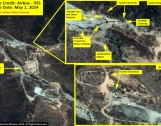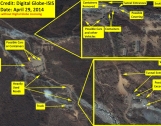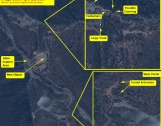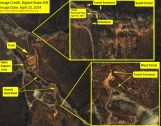Reports
North Korea’s Punggye-ri Test Site: Activities Continue on May Day 2014
by David Albright, Serena Kelleher-Vergantini, and Priscilla Kim
May 2, 2014
Airbus high resolution commercial satellite imagery from Thursday, May 1, 2014 shows continued activities and movement of vehicles at North Korea’s Punggye-ri Nuclear test site (see figure 1). Specifically, movement of possible cars and other vehicles has been detected at the South Portal.
ISIS has been monitoring and updating its analysis of the site (see previous ISIS Imagery Brief) using satellite imagery dated April 23, 25, and 29, 2014 which are included as figures 2, 3, and 4. On the evening of May 1, 2014 ISIS received higher resolution Airbus satellite imagery showing the movement of the vehicles identified in the previous brief.
On April 29, 2014 the cars and other vehicles were spotted on the small road leading toward the South Portal tunnel entrance. On May 1, 2014, two of the black cars are located adjacent to one of the two South Portal tunnels and the lighter-colored vehicle (or possibly the white truck spotted both at the South and West Portals in previous imagery) is close by.
What was initially identified as possible camouflage netting at the South Portal remains (see figure 1). However, the use of more data-rich imagery suggests that the item may not be a netting material, rather a more solid material such as a tarp or other type of covering. Additionally, it is hard to determine whether this object is collocated adjacent to the tunnel entrance or slightly removed from the entrance. This higher resolution imagery shows a trench possibly used to drain water from the tunnel entrance areas. Finally, an oddly shaped object appears more clearly in the South Portal area but at present ISIS is unable to identify it.
At the West Portal, the large white truck, which on April 29th was spotted near this portal, is no longer present. All these activities are consistent with the view that a test or tests will occur soon. However, the exact timing of a test or tests is difficult to construe from the on-going activity. Moreover, recent North Korean official statements have added to the uncertainty about when a test could occur. With more time, the United States and China have additional opportunities to press North Korea not to test.
Images

Figure 1. Airbus imagery showing North Korea’s Punggye-ri nuclear test site May 1, 2014.
Figure 2. Digital Globe imagery showing North Korea’s Punggye-ri nuclear test site on April 29, 2014.
Figure 3. Digital Globe imagery showing North Korea’s Punggye-ri nuclear test site on April 25, 2014.
Figure 4. Digital Globe imagery showing North Korea’s Punggye-ri nuclear test site on April 23, 2014.

 twitter
twitter